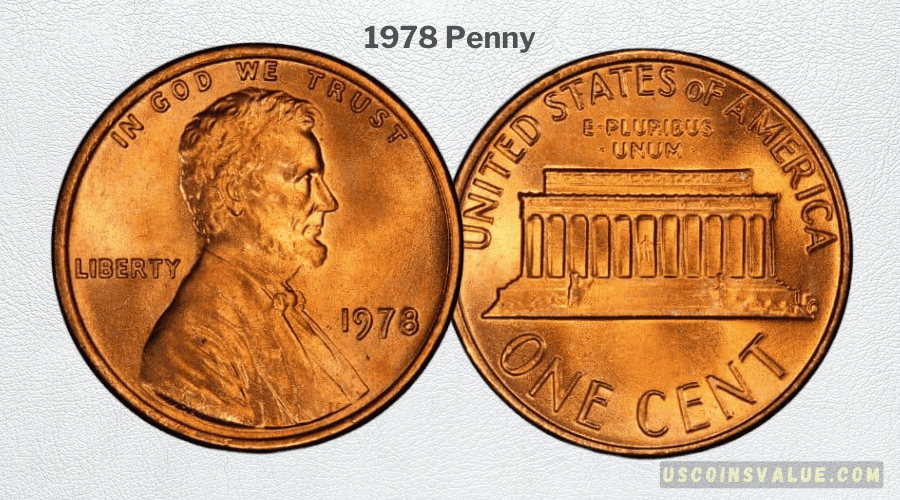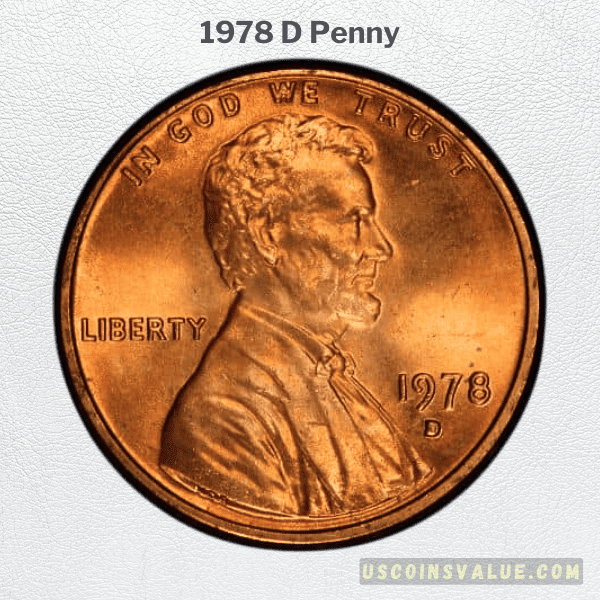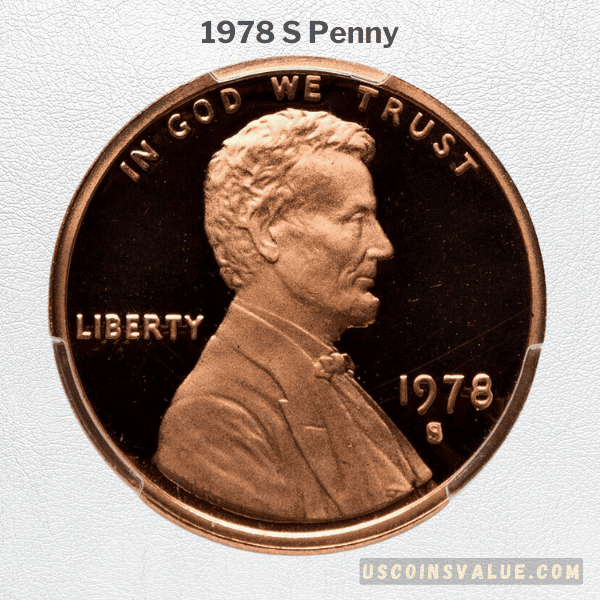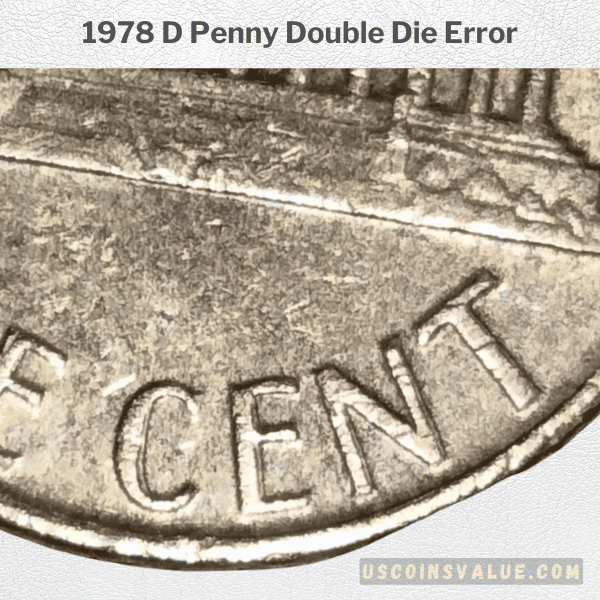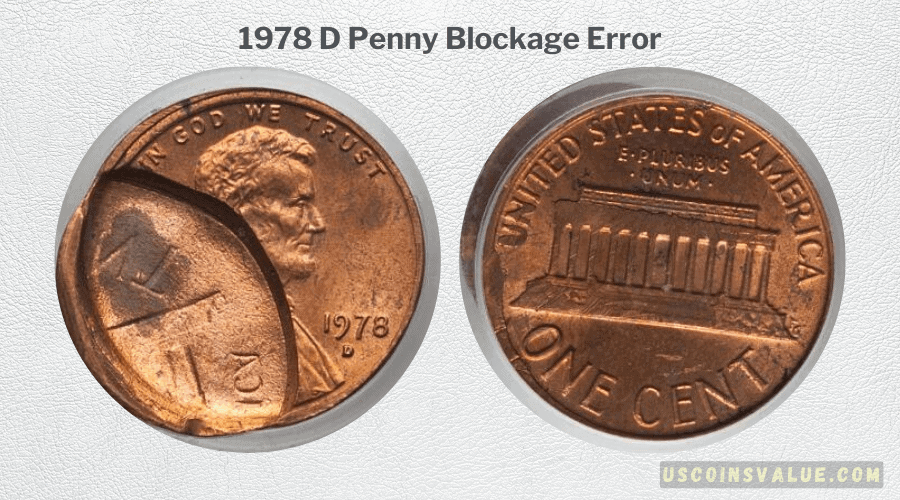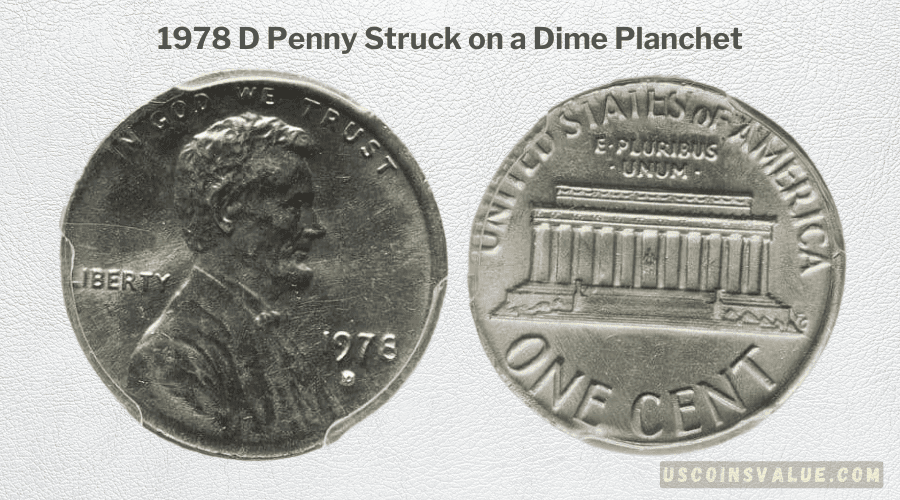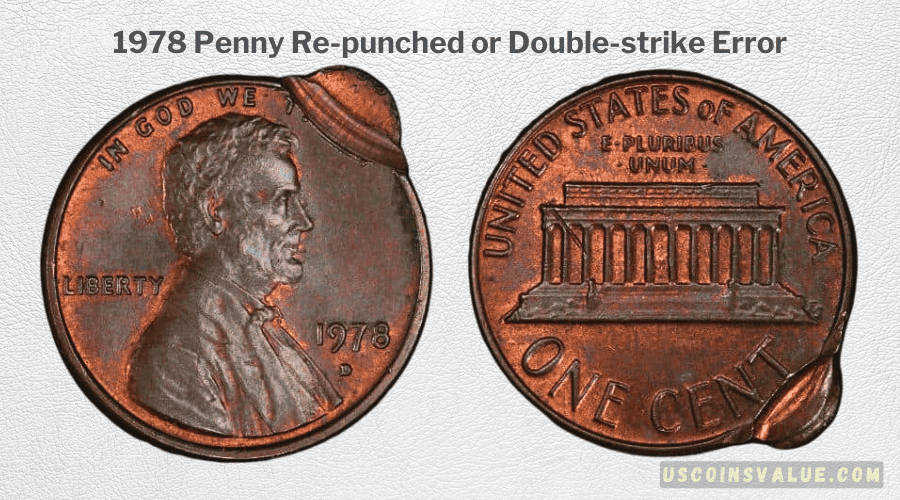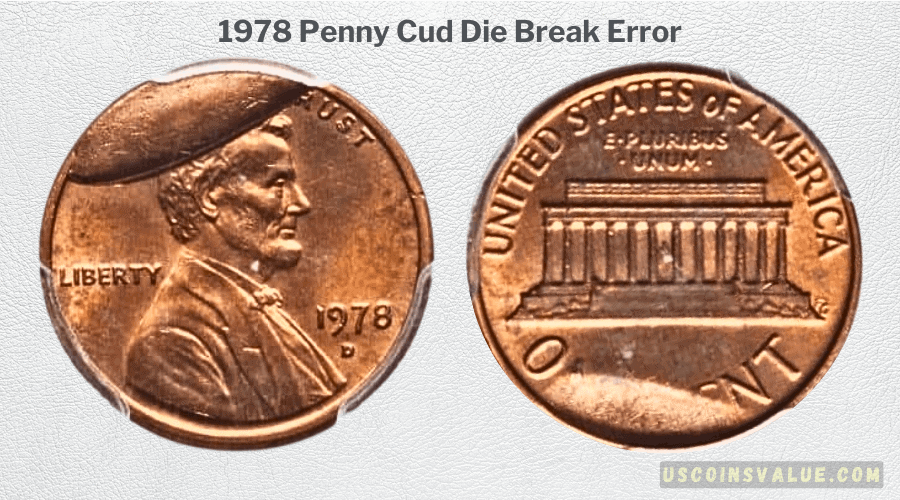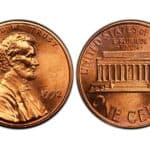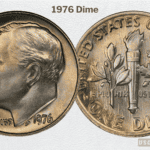Seasoned collectors know that coins appreciate with age like good wine. That’s one reason the 1978 penny value would rise from its $0.01 face value to a whopping $4,313.
It’s over four decades since the minting of the 1978 penny. Still, coin collectors use their penny grading skills to spot any precious pieces in circulation. If the penny is kept away safely in its mint uncirculated form, that would make it a rare find.
So, why is a 1978 penny so valuable?
That’s what you are about to find out in this article. We tell you why coin collectors are on the lookout for unique 1978 pennies and how you can assess the coin for value if you have one among your pocket change. Let’s set the ball rolling!
1978 Penny History
Coins have an interesting history around their minting. For the 1978 penny, details about its history relate to significant events before and after its casting.
- The 1909 Lincoln Memorial
The 1978 penny is part of the Lincoln Memorial series initiated in 1909 to celebrate 100 years since the birth of the 16th president of America.
That year, Victor David Brenner’s design of Abraham Lincoln replaced the former coin designs. As such, the former President’s image became the first actual human image on a US coin.
- The 1959 reverse design change
Nineteen years before the casting of the 1978 penny, artist Frank Gasparro’s design of the Lincoln Memorial Monument replaced the wheat design that was on the reverse since 1909.
- The 1982 copper price inflation
The 1978 penny is among the last series made from more copper (95%) and minimal zinc (5%).
The 1982 inflation occasioned this change. The recession is considered the worst after the Great Depression associated with the 1929 stock market crash and before the 2007/09 recession.
Due to the 1982 inflation, copper became extremely expensive. The price increase prompted America to make her penny coins from a majority of zinc (97.5%) and a 2.5% copper coating.
All three historic details can determine a 1978 penny value if submitted in its mint state, its copper is melted, or there are rare errors on the coin.
1978 Penny Details
Coin collectors focus on details related to their physical presentation. Features of focus include the coin’s specifications and the obverse and reverse designs and inscriptions.
1978 Penny Specifications
Although most physical specifications of the 1978 penny are the same as those of later mints, the penny has one differing spec: Its weight.
The 1978 penny weighs 3.11g, an additional 0.61g compared to today’s 2.5g pennies. That’s because copper is heavier than zinc and the 1978 penny has a high copper base. The high copper composition also explains the penny’s $0.2 value in its melt state.
On that note, you should know that the US has a prohibiting rule for melting the one-cent and 5-cent pennies, effective April 2007.
Back to our focus issue, you can find the complete 1978 penny specifications in the table below.
- Metal: 95% Copper and 5% Zinc
- Face value: $0.01
- Weight: 3.11g
- Diameter: 19.05mm
- Thickness: 1.52mm
- Edge: Plain (no reeds)
1978 Penny Obverse and Reverse Designs and Inscriptions
Coins have heads and tails or, in proper numismatic terms, the obverse and the reverse sides. Each of these sides bears unique identifying features depending on the penny series.
If you are an aspiring coin collector, you should know that every detail on a penny of interest counts. That includes its physical components and features and details of the design.
The 1978 penny obverse side bears the bust of Abraham Lincoln, seen from a side angle. The following inscriptions surround the image at different positions:
- IN GOD WE TRUST – above the image of Lincoln.
- LIBERTY – Behind the image.
- 1978 – This is the mint year that appears in front of the image.
- ‘D’, ‘S’ or no mint mark – These appear below the mint year to indicate the mint location: Dever (D), San Francisco (S), or Philadelphia (no mint mark or P).
The reverse side has Lincoln’s memorial monument at the center. You can see a miniature image of Lincoln within the bars of the monument. The following inscriptions surround the monument:
- UNITED STATES OF AMERICA – Curved above the monument.
- E PLURIBUS UNUM – A motto that translates to “Out of Many, One” appears inside the concave set over the memorial by the name of the country.
- ONE CENT – Inscribed below the Monument.
1978 Penny Value and Varieties
The mint mark determines the 1978 penny varieties. Graders decide the penny’s value on its condition (uncirculated mint form or circulated in good condition) or the presence of clear mint errors.
Before discussing the 1978 value and varieties in detail, here’s a summary 1978 penny value chart, going by the USA Coin Book estimations.
1978 Penny Value Chart:
| Variety | Melt Value | Uncirculated
(MS/PR 65) Value |
Highest Selling Value (to date) |
| 1978 ‘no mint mark penny | $0.0259 | $1.16 | $ 4,259 |
| 1978 “D” penny | $0.0259 | $1.16 | $546 |
| 1978 “S” penny | $0.0259 | $2.88 | $4,313 |
As we tell you in the details below, the 1978 penny can rise from its face value to the highest selling value depending on variety, condition/grading, and the presence of mint errors.
1978 No Mint Mark Penny
The Philadelphia Mint struck 5,558,605,000 of the over 9 million pennies produced in 1978. The 1978 penny from this Mint does not have the P mark, explaining why numismatists and coin collectors describe it as the 1978 no mint mark penny.
Since many years have gone, it’s extremely difficult to find a 1978 no mint mark penny in its mint form.
A circulated 1978 penny no mint mark is worth its face value of $0.01 and has a $0.02 melt value. However, the Penny can increase in value if it has visible errors or is assigned a high grade.
For example, a 1978 no mint mark penny graded MS67RD sold for $ 4,259.38 in 2014 at the Heritage Auctions. This is the highest value on record for a 1978 no mint mark penny.
Lower prices for a 1978 no mint mark penny range around $1.16 for an uncirculated MS65 penny.
The value can appreciate by hundreds of dollars if the coin has one of the 1978 penny errors valued by collectors. For example, a 1978 penny no mint mark with an MS62RB rating and a double die error sold for $661 at the Heritage Auctions in 2004.
A few other examples from actual sale records will give you an idea of the 1978 no mint mark penny value on the higher end (sorted by date of sale):
| 1978 No Mint Mark Penny Value (Higher Prices) | |||
| Grade | Price | Auction | Sale Date |
| MS67RD | $1,410 | Heritage Auctions | 2016 |
| MS67RD | $1,703 | Heritage Auctions | 2016 |
| MS67RD | $3,818 | Heritage Auctions | 2013 |
| MS67RD | $1,610 | Heritage Auctions | 2010 |
| MS67RD | $1,150 | Heritage Auctions | 2006 |
Current market values for a 1978 no mint mark penny vary widely. According to Greysheet, the average value range for a regular 1978-P penny is $0.60 – $182.00.
1978 D Penny
The Denver Mint cast the 1978 D penny variety. A total of 4,280,233,000 pennies struck in that year bear the D mint mark.
Like the 1978 no mint mark penny, the 1978 D penny is widely circulated. For this reason, collectors do not consider it a unique coin unless it has rare errors or a high grading.
1978 D pennies are worth less than the 1978 no mint mark variety, and a four-figure price for the D variety is rare. In fact, the highest-selling 1978 D penny with an MS67RD grading traded for $546 at the Heritage Auctions in 2008.
Prices of the 1978 D penny only go down from here and are extremely rare, even on actual sale records. We show you a few examples in the table below.
| 1978 D Penny Value | |||
| Grade | Price | Auction | Sale Date |
| MS65RB | $99 | Heritage Auctions | 2019 |
| MS62RD | $126 | Heritage Auctions | 2019 |
| MS67RD | $204 | Heritage Auctions | 2013 |
| MS67RD | $258 | Heritage Auctions | 2016 |
| MS67RD | $258 | Heritage Auctions | 2015 |
The US Coin Book indicates a $1.16 price for an uncirculated MS65 1978 D penny value, the same as a 1978 no mint mark penny in identical grade. Some current price listings suggest a little more for pennies with higher grading or visible penny errors.
For example, a 1978 penny on etsy.com showed a $32 listing at the time of writing. Since the description did not show any grading by a reputable agency such as the PCGS or NGC, we recommend consulting a professional grader in such cases to rule out a counterfeit coin.
1978 S Penny
The 1978 S penny variety consists of proof pennies minted at the San Francisco Mint. Proof pennies are made with utmost precision and bear an extra sheen. They show an extra-glossy appearance compared to the ‘P’ and ‘D’ circulation pennies.
Because the San Francisco Mint makes them in lesser quantities, proof pennies are rarer and have higher values than circulation pennies. The San Francisco Mint made only 3,127,000 proof pennies in 1978.
The US Coin Book indicates a $2.88 value for the 1978 S penny with a PR65 grade. This price is more than double the $1.16 for the D and the no-mint mark 1978 pennies in the same grade.
The highest-selling price for a 1978 S penny was $4,313 in 2008 at Heritage Auctions. The DCAM (Proof) penny had a PR70 grading.
Current market prices for the 1978 S penny can vary with the coin condition/grading and the listing market. For example, at the time of this write-up, a 1978 S PR70 DCAM penny is listed at a $210 highest bid on Heritage Auctions.
Instead, Amazon.com lists a 1978 penny with no specific grading details for $9.49. Remember to seek the counsel of a professional grader before going for pennies without certified service grading.
If you wonder how to grade a 1978 penny coin yourself, you’ll find the next section interesting.
1978 Penny Grading
Grading a coin determines its value and so, its monetary worth.
While professional coin grading is an art that people learn with years of experience, you can use available resources to determine what grade your 1978 penny would likely fall into.
We recommend using the American Numismatic Association (ANA) grading standards and terminologies for uncirculated (mint-state) and circulated coins.
Here’s what you do.
- Take a coin magnifier and assess your 1978 penny.
- Use the ANA grading standards (whose link appears above) to determine your penny’s grade.
When you submit the penny to coin collectors for auction, they will still grade the penny appropriately. But assessing it yourself will give you an idea of what to expect.
Your 1978 pennies will also be assessed for rare errors because those can significantly increase the penny’s value.
Rare 1978 Penny Errors
The 1978 D penny has some glaring but rare errors. Luckily, these errors work to your advantage when you submit a coin to a collector. That’s because they add value to the coin and are worth good money.
Some major 1978 D penny errors can make your coin significantly appreciate in value. Others are worth a few additional dollars to the regular 1978 penny value.
We explain the 1978 D penny errors here with some factual examples.
1978 D Penny Double Die Error
The double die error often happens in coin mintage and is still an error of interest to coin collectors.
The error forms if the mint worker strikes the coin while the die is misaligned, creating the illusion of a second image on top of the original one.
Double die errors on the 1978 penny are minor and will add a few or more dollars to its value depending on the extent of the error.
For example, an MS66BN 1978 D penny with a double die error sold for $100 on eBay in 2021.
1978 D Penny Blockage Error
The blockage error occurs when a coin does not eject from the die and a blank stays between the coin and the die hammer. As such, one side of the penny will have a regular design and the other a blocked image of the same design.
Blockage errors can be minor or extensive. When vivid, they can appreciate the penny value from a few bucks to hundreds of them.
In 2019, an MS62RD 1978 D penny with a 40% blockage on the obverse sold for $126 at the Heritage Auctions.
1978 D Penny Struck on a Dime Planchet
When a penny is struck on a dime (10-cent) planchet, it has a smaller size and thickness than the regular penny coin. The penny also appears in a copper-nickel blend characteristic of dime mintage.
Since the penny is in good condition, the size and metal combination error can appreciate its value from a few dollars to hundreds of dollars.
For example, in 2023, an MS63RD 1978 D penny struck on a 10-cent planchet sold for $384 at the Heritage Auctions.
1978 Penny Re-punched or Double-strike Error
The double-strike or re-punched error occurs when a mint worker misguidedly puts the penny into the die twice.
A double-strike repeats the design on the coin and can appear a bit or clearly offset from the center without showing the regular details.
A double-strike 1978 penny can slightly rise in price from the few dollars of a regular penny. For example, an MS63RB 1978 D penny, with a 95% off-center double strike, sold for $74 at the Heritage Auctions in 2021.
1978 Penny Cud Die Break Error
The cud die break error is formed on a coin when some die breaks and creates a cavity. The cud can appear as a blank space in an irregular or ovoid shape.
Like other 1978 penny errors, the cud die break error can yield some extra bucks to the price of your coin. In 2021, a 1978 D penny graded MS63RD with a cud die break on the obverse sold for $156 at the Heritage Auctions.
Concluding Thoughts
Like all the pennies minted in other years, the 1978 penny is worth a cent ($0.01) at face value.
However, if the 1978 penny has preserved its mint state over the years and has a high grading, it can sell for hundreds or thousands of dollars. 1978 pennies with mint errors also have a higher value.
If you think your 1978 penny is a rare find, assess it on the American Numismatic Association standards. That way, you know if it’s worth submitting to coin collectors for a few or many extra bucks.

